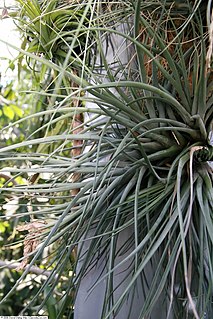
Spanish moss is an epiphytic flowering plant that often grows upon large trees in tropical and subtropical climates. It is native to much of Mexico, Bermuda, the Bahamas, Central America, South America, the Southern United States, and West Indies. It has been naturalized in Queensland (Australia). It is known as "grandpa's beard" in French Polynesia.

Tillandsia is a genus of around 650 species of evergreen, perennial flowering plants in the family Bromeliaceae, native to the forests, mountains and deserts of northern Mexico and south-eastern United States, Mesoamerica and the Caribbean to mid Argentina. Their leaves, more or less silvery in color, are covered with specialized cells (trichomes) capable of rapidly absorbing water that gathers on them.
Tillandsia botterii is a species in the genus Tillandsia. It is endemic to Mexico.
Tillandsia crista-galli is a species of flowering plant in the genus Tillandsia. This species is endemic to Mexico. The specific epithet has also been spelt crista-gallii.
Tillandsia elizabethae is a species in the genus Tillandsia. This species is endemic to Mexico.
Tillandsia jaliscopinicola is a plant species in the genus Tillandsia. This species is endemic to Mexico.
Tillandsia marabascoensis is a species of flowering plant in the family Bromeliaceae, native to southwestern Mexico. It was first described in 1992.
Tillandsia socialis is a species of flowering plant in the genus Tillandsia. This species is endemic to Mexico. It was first described in 1958.
Tillandsia zoquensis is a species of flowering plant in the family Bromeliaceae, endemic to southeastern Mexico. It was first described by Renate Ehlers in 2002.

Tillandsia fasciculata, commonly known as the giant airplant or cardinal airplant, is a species of bromeliad that is native to Central America, Mexico, the West Indies, northern South America, and the southeastern United States. Within the United States, this airplant is at risk of extirpation from the Mexican bromeliad weevil, Metamasius callizona.

Tillandsia ionantha, the air plant, is a species of plant in the genus Tillandsia. This species is native to Central America and Mexico. It is also reportedly naturalized in Broward County, Florida.
Tillandsia polita is a species of flowering plant in the family Bromeliaceae, native to Mexico and Central America. It was first described by Lyman Bradford Smith in 1941. As of October 2022, the Encyclopaedia of Bromeliads regarded it as a natural hybrid of Tillandsia rodrigueziana and Tillandsia rotundata.

Tillandsia rhomboidea is a species of flowering plant in the family Bromeliaceae, native to Bolivia, Colombia, Costa Rica, Ecuador, Honduras, southeastern Mexico and Venezuela. It was first described by André in 1888.
Tillandsia rotundata is a species of flowering plant in the family Bromeliaceae, native to Guatemala, Honduras and southeastern Mexico (Chiapas). It was first described by Lyman Bradford Smith in 1945 as the variety rotundata of Tillandsia fasciculata and raised to a full species by Cecelia Sue Gardner in 1984.

Tillandsia heliconioides is a plant species in the genus Tillandsia. This species is native to Mexico, Central America and South America.

Mitrastemon is a genus of two widely disjunct species of parasitic plants. It is the only genus within the family Mitrastemonaceae. Mitrastemon species are root endoparasites, which grow on Fagaceae. It is also a non-photosynthetic plant that parasitizes other plants such as Castanopsis sieboldii. The parasitic plant was first discovered by botanist Eizi Matuda during an expedition to Mt. Ovand in the state of Chiapas, Mexico. The different species were originally named by a friend of Matuda, Yamamoto in 1925–1926. Mitrastemon yamamotoi is a protandrous plant. Its flowers go through a male phase before transforming into their final female form. The flowers of M. yamamotoi attract a variety of insects ranging from wasps to flies and beetles. Among these, beetles are the best pollinators for this plant since their visit to the flower would pick up a large amount of pollen and they would pollinate from each of the flowers that they had already visited. The plant is endemic to tropical and subtropical forest regions such as Southeast Asia and Japan.

Eiji Matsuda (1894–1978) was a Mexican botanist of Japanese origin. In scholarly works his name is generally romanised as "Eizi Matuda" following the "Kunrei" system.

Tillandsia subg. Tillandsia is a subgenus of the genus Tillandsia.

Tillandsia subg. Viridantha is a subgenus of the genus Tillandsia.







